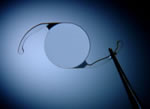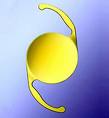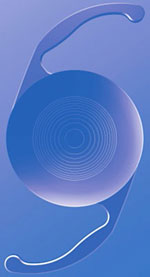Back to Cataract Menu
Monofocal IOLs


Multifocal IOL

Multifocal rings on the IOL surface

ACS Eye Specialist Centre
95G & 97G Jalan TKS 1,
Taman Kajang Sentral,
43000 Kajang,
Selangor, Malaysia.
Tel: 03-82116078
Waze or Google Map
Multifocal or presbyopia correction IOL (lens implants)
The debate rages on! Sorting out fact from marketing double talk requires some prudent knowledge prior to having one of these "latest lenses" or "premium IOLs" implanted during cataract surgery.
These days, if you walk into one of the eye centres for refractive/cataract treatment and you'll be most likely counselled to have a presbyopia or multifocal lens implanted because it is the latest and "best" lens nowadays. You will be told that you will have "vision like when you were young" again.
However the cost of using these presbyopia or multifocal lens is twice the price of implanting the latest generation of monofocal lens. So the question is, are these lenses worth twice the amount for the surgery?
Intra-ocular lenses used for cataract/refractive surgery can be defined into 3 categories:
- Mono-focal IOL
- Multi-focal (a.k.a presbyopia correction IOL)
- Accomodative IOL
Mono-focal lens -
currently provides the best quality vision of all the lenses. The drawback is they are not variable focus, therefore the patient is given the choice to be near-sighted or far-sighted.
- If you have chosen to be far-sighted, you will need to wear glasses for reading near.
- If you have chosen to be near-sighted, you will need glasses for distance viewing e.g. driving, playing golf. However reading or close work can be done without glasses.
The benefit of mono-focal lens over the other lenses is that it gives the best quality of vision without glasses and with glasses.
Multi-focal (a.k.a presbyopia correction IOL) -
these lenses have stirred a lot of controversies among ophthalmolgists. There are those that believe the benefits out weigh the short comings of the lenses. The intention of this lens is to do away with the need to wear glasses after cataract or presbyopic correction surgery. Unfortunately there has yet to be an artificial lens to be designed that is as good as our natural lens we were born with. To understand why this lens is not perfect we have to understand the design of this lens.The multifocal lens to put it in laymen's terms is a lens that normally has the focus of the lens divided into two focus points, near and far. Therefore certain portions of the lens allows focusing for far and the other portions for near sight. This allows the patients eye to see both near and far. However because there are mainly 2 images formed simultaneously, the patient has to neurologically adapt the brain to chose which image they want to use. This can cause problems. In the initial period all patients will experience seeing the altered vision. It may take months to finally adapt and patients who cannot adapt tend to end up very disatisfied.
Additional problems of this lens is because it has two different focus points. In normal light conditions the lower quality of vision is described as "waxy". In low light conditions like in the evening or night, the quality of vision is affected by disturbances of glare and haloes due to the design of the lens. Contrast sensitivity too is reduced compared to a patient with a mono-focal lens.
Another problem with these lenses are that they are not truly multifocal but normally "dual" focal. They focus for two distances. For those that focus for far and near, often the intermediate distance, which is the distance one uses a computer, cooks or looks at the instrumentation of the car while driving, is not in focus or blur as the lens is designed for distance (infinite) and near (reading). If one chooses IOLs are designed for distance and intermediate , the near vision ends up not to be so good. Basicially one can't have the best of all worlds.
Because of these short coming of the multifocal lenses, there has been a lot written and discussed among ophthalmologists about how to select and screen patients that can accept the short-comings of the multifocal IOL. The personalities and lifestyles are taken into account in patient selection as the patients who cannot accept the defects of this design are extremely dissatisfied. Those who can accept the side effects of the multifocal IOL have the benefit of not having to wear glasses most of the time for their lifestyle needs are happy.
The manufacturers of these IOLs invest a lot in resources, studies and marketing to convince the ophthalmologists and patients to use their products. Ultimately it is for the patient to decide whether the lens suits their requirements as once implanted it is not as easy to ex-plant and re-implant a mono-focal lens that does not have those side effects.
My prediction is that the future of this lOL is limited and this designed will be abandoned once the accomodative IOL designed is improved on.
Accomodative IOL -
This design is very much closer to our natural lens as the accomodative IOL is supposed to be variable focus. This is where the IOL will change focus according to the distance of the object we are looking at, much like the camera lens does. To date, the few accomodative lens on the market work to a limited extent and are not always successfully for all patient. Also their range of focus is only about 1 to 1.5 diopters, whereas for a complete range of focus we need an IOL that can vary the focus for us up to 4 diopters.More research is being done to improve these accomodative and everyone is eagerly awaiting for the days when a fully working accomodative IOL will become available.
Summary
Therefore, as you see, there is currently no artificial lens that can be implanted into the human eye that can provide "vision as good as when we were young". We have a few options to choose from and they are all a compromise. It is up to the patient to choose according to their need, lifestyle, expectations of vision quality and budget.Excerpts of interest
On the international scene here are some extracts of the joint plenary session of the 21st APACRS Annual Meeting 2008 from the experts around the world about the latest IOL designs.Dr. Graham Barrett: Although initally impressed with the promise of multifocal IOLs, Dr. Barrett confessed to being skeptical of the visual results they provide. Dr. Barrett's preferred path to correcting presbyopia is monovision: a monofocal IOL is implanted in the dominant eye, targeting emmetropia for distance; the non-dominant eye is left myopic for near vision.
(* At ACS Eye Specialists, from our own experience, our patients who have decided to go with monovision are extremely satisfied with the results. Furthermore they did not need pay for the higher price multifocals to be spectacle/glasses free.)
Dr. Michael Knorz - Although "we would like accomodation, " he said, lenses that provide true accomodation "are not yet possible." Multifocal IOLs, Dr. Knorz said, provide the best reading vision (compared to the current accomodative lenses), but have more side effects and is thus best for patients who actively dislike glasses and are willing to accept the compromised, "waxy" vision and side effects, such as halo and glare, to do away with them. Patient selection and education are thus paramount to success with multifocal IOLs, he said. Dr. Knorz pointed out that all three approaches to presbyopia vision are valid but that the choice between them will depend on the particulars of each patient.
Back to Cataract Menu